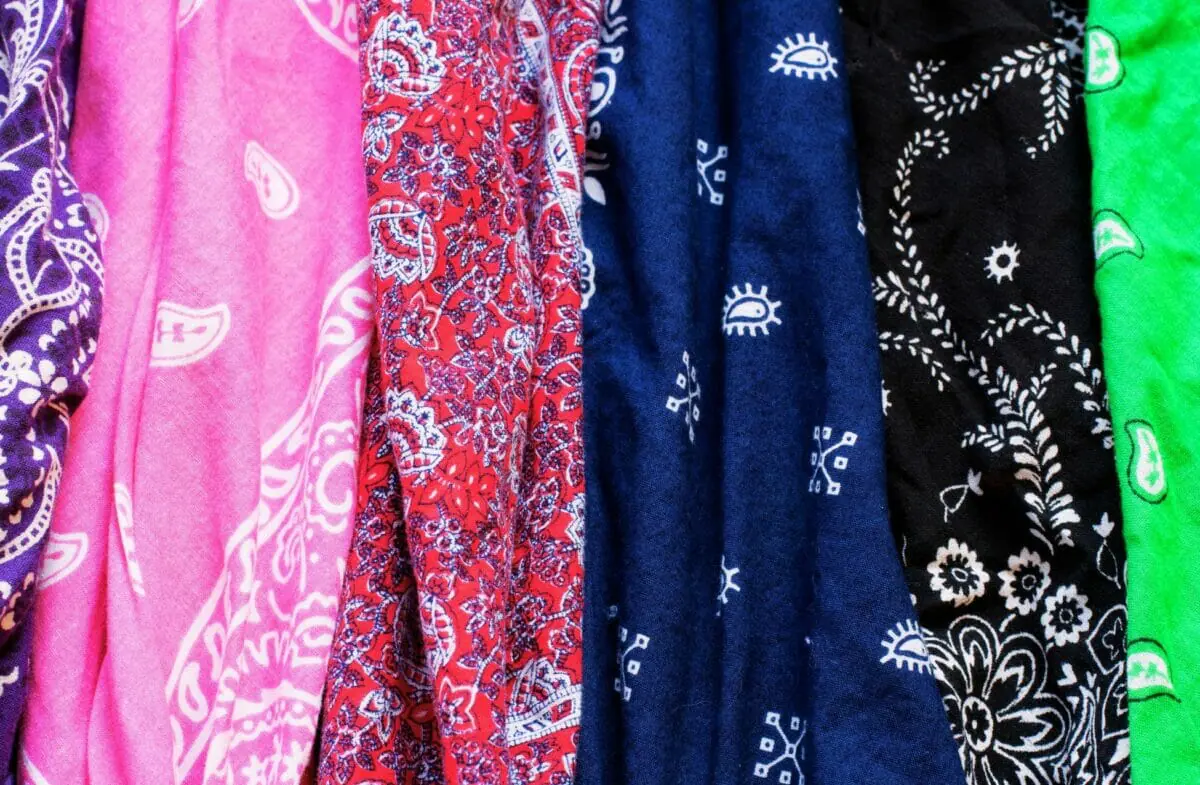Have you ever been among a group of gay guys and noticed an abundance of handkerchiefs in their pockets? Perhaps you also notice that they seem to be in pants and shirt pockets. If you’re not familiar with the gay community, you’ll probably conclude that it’s some new trend.
After all, trends seem to change every minute these days, and it’s almost impossible to keep up. So you’ll just shrug it off and carry on. If you know about the gays, though, you’ll very likely assume it’s a gay hanky code of some sort, and you’d be right.
Gay hanky codes, also known as handkerchief codes or bandana codes, have been a part of the LGBTQ+ community for decades. These codes involve wearing a colored handkerchief in a specific pocket or a particular location on your body to communicate one’s sexual interests and fetishes to others. The color or pattern indicates the type of sexual activity, while the position shows your preferred role.
The history of the gay hanky code (or bandana code, as it is sometimes called) is a long and interesting one. The origins are not even rooted in gay culture. Instead, its beginnings can be found in the mid-19th century when it was used by tens of thousands of cowboys, miners, and railroad engineers in the Western United States.

It is believed that the practice of wearing bandanas by men started in San Francisco during the Gold Rush when men who were dancing with each other in square dances used the color of their bandanas to signify whether they were taking the male or female role in the dance.
This code was used because there were few women present, so each man had to play either the male lead or female follower role during a dance. The man wearing a blue bandana would take the male lead role, while the man wearing a red bandana would take the female follower role.
Over a hundred years later, in the thriving gay culture of 1970s New York City, gay men needed a code to indicate not only their sexuality but also the role they played. Presuming was dangerous, as approaching the wrong person could lead to you being arrested, thrown in jail, or killed. Discretion was of the essence. Members of the leather community came up with a means of communication.
Most of them already wore keys on their belt loops. Wearing their keys on their left belt loop came to signify that the man was a top, while wearing it on the right meant that they were a bottom.
It is claimed that the use of the hanky code in those times came about after a joke made by a journalist from The Village Voice, an alternative weekly newspaper and one of the first sources of information for queer people in New York City.
The journalist joked that gay men should turn to different-colored handkerchiefs as a more efficient way to indicate their sexual interests instead of using the keys. The community seemingly embraced the idea, and the gay hanky code was adopted.
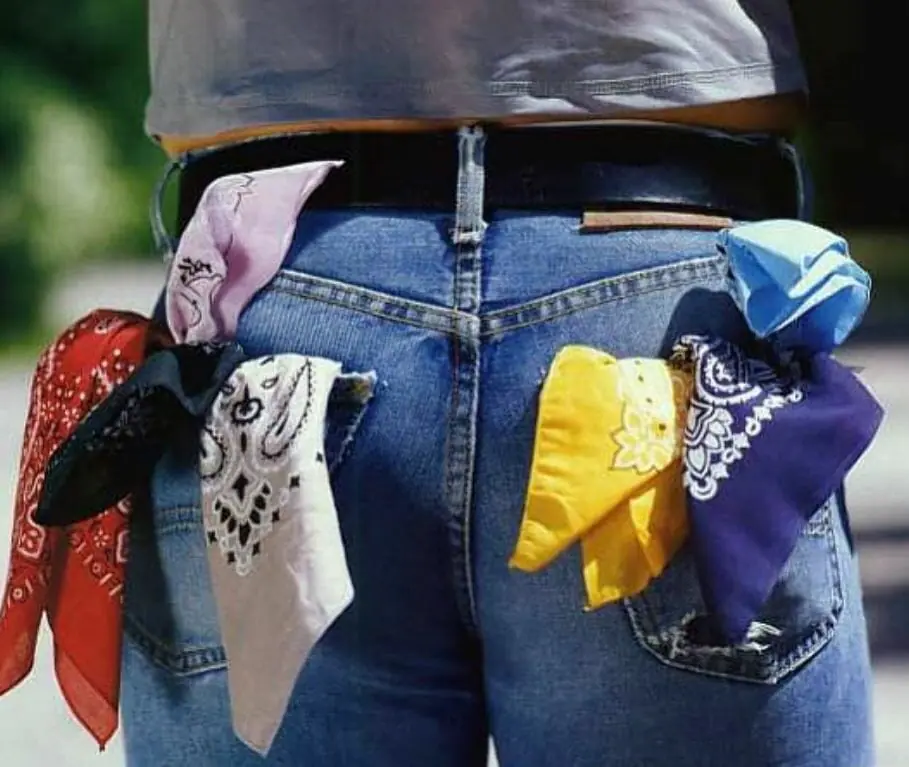
According to some scholarly sources, the adoption of hanky codes by the gay community was speared by a department store in San Francisco for erotic merchandise known as The Trading Post. Around 1971, the store began to promote colored handkerchiefs in their store and even printed and distributed cards with their meanings.
Since the meaning of the red and blue handkerchiefs was already known, all they needed to do was assign meanings to other colors and print them on the cards. This version of the story can be found in Hal Fischer’s Gay Semiotics.
There is also a claim by Alan Selby, founder of Mr. S Leather in San Francisco, that he, along with his business partners at Leather ‘n’ things, created the first gay hanky codes. According to him, they accidentally received a double order of bandanas and had to quickly come up with a way for them to sell out the items. Necessity is the mother of invention, as they say, and the solution was to create an expanded code to help them get rid of the excess inventory.
Beginning in 1964, Bob Damron, a businessman, punished a list of all the gay bars he’d visited on his travels across the United States. The book was called Bob Damron’s Address Book, and it featured gay bars, theatres, bathhouses, and cruise areas he’d visited. An early version of our gay travel guides, the later versions of this even featured lists of the gay hanky codes that existed at that time.
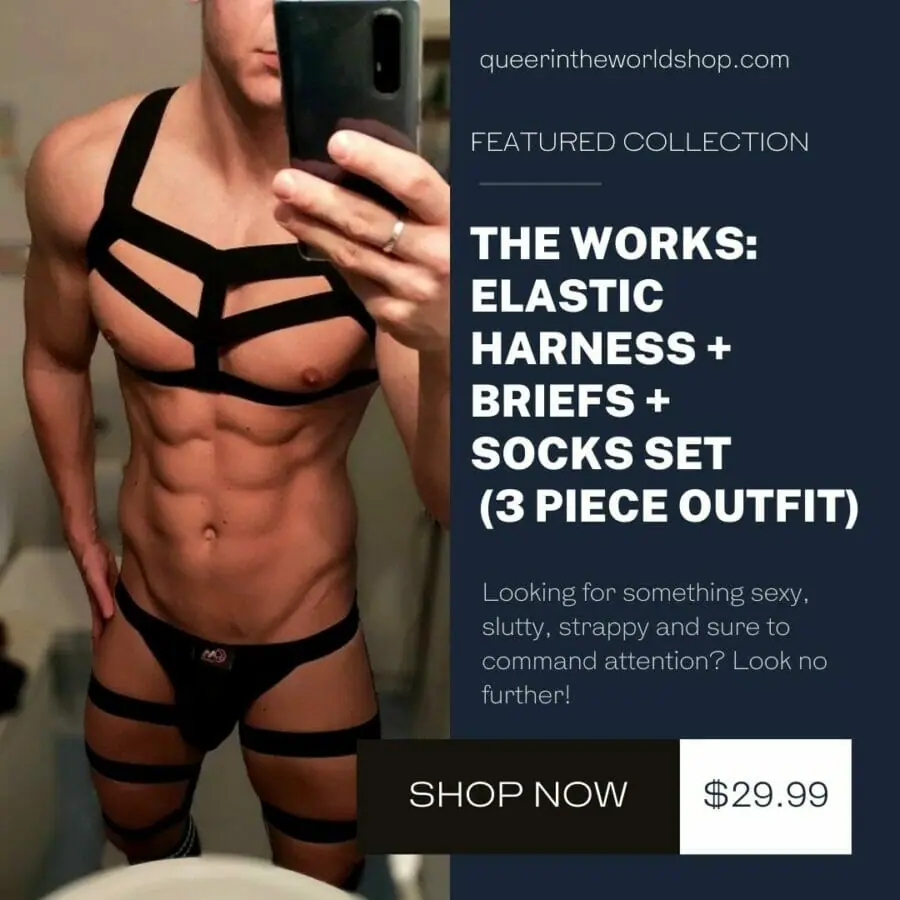
History, especially queer history – one of pride and resilience – is important, so the origin of gay hanky codes should not be pushed aside. However, it is equally as important to look to the here and now. Today, there exists a robust vocabulary of colors, positions, and meanings.
Although more modern forms of communication exist and secrecy is no longer necessary in most places, the use of these colored handkerchiefs to communicate is still practiced among gay people. Perhaps the awareness that gay rights and gay bodies are always under threat has not allowed the practice to fade into obsoletion.
We are going to try to explain some of the hanky codes and their meanings. This isn’t an exhaustive list, naturally, and there are several that won’t feature in it. We hope that most of them do, though. Before we dive in, it’s vital to know that the placing of the item on the left side indicates that the wearer is a top, while placing it on the right indicates that the wearer is a bottom.
For acts like fisting, water sports, etc, the bandana is worn on the left side for the person carrying out the act, and on the right side for the person receiving the treatment.
The sides in question can either be a pocket – usually the back pocket – or the arm. For the latter, the bandana is tied around the left or the right upper arm. To indicate that the wearer is versatile, the bandana is tied around the neck or tucked down the front or back of the pants, as centered as possible. Now, let’s get to the colors and what they stand for.
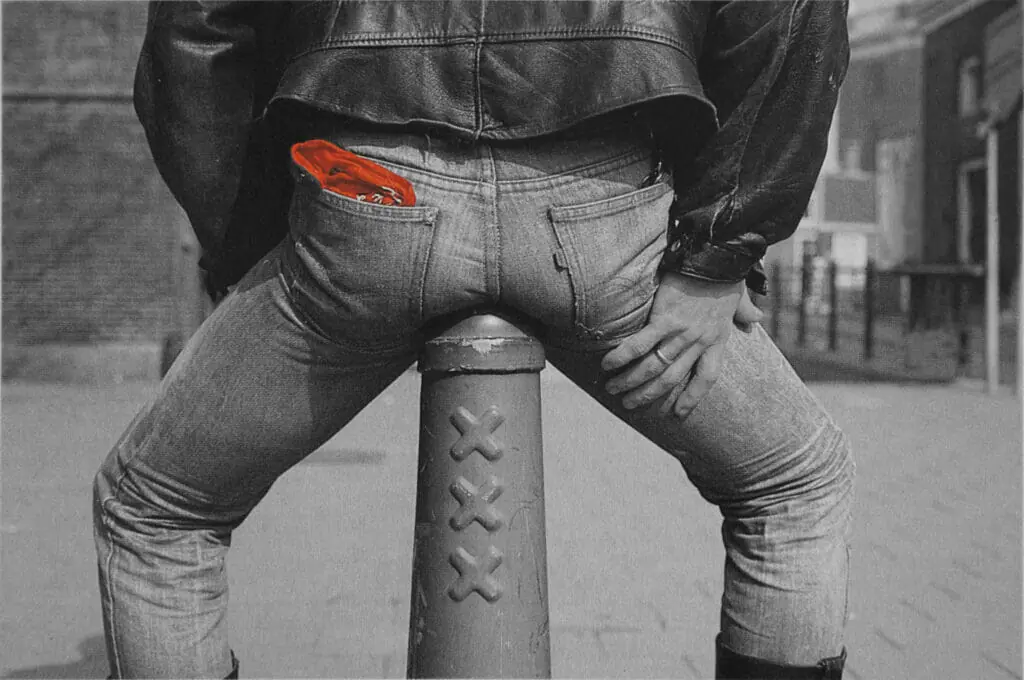
In this article we will cover...
Black
If you see someone wearing a black bandana or handkerchief on their left side or carrying it in their left pocket, it means they are interested in participating in the act of BDSM or Dominance. If it is worn on the right side, it means they are open to being dominated, i.e. they are submissive.
A black and white checked bandana is a welcome sight, as it shows a top – or bottom – who is big on safe sex. If the bandana had a white stripe, it means its bearer is a black bottom (i.e. they’re a top) or vice versa. If you see a black velvet handkerchief sticking out from a left pocket, the person likes to make videos. If it’s in the right pocket, the person enjoys performing for the camera.
Grey
We weren’t sure whether charcoal falls under gray or black, but whatever the case, charcoal stands for a latex fetish top or bottom, depending on the position hanky, of course.
Gray is used to indicating a person looking for bondage, with the left side standing for bondage top and the right indicating a bottom who loves bondage. Grey and black mean that they’re into light SM, and grey flannel has to do with suits: wearing them or liking men that wear them.
Red
A red bandana or handkerchief worn on the left indicates that the wearer is into fisting. Worn on the right side, it means the wearer is into being fisted. If the handkerchief is dark red, it signifies two-handed fisting. Again, the same law applies as to the sides.
Maroon, a reddish brown, stands for something more hardcore – cutting. The top does the cutting, of course. And if the red has a white stripe, it means the bearer enjoys shaving/being shaved, again keeping in mind the side. If the white stripe is black, it stands for the opposite, with the person being a furry bear or wanting to be fucked by one.
Pink
Light pink and dark pink have to do with dildo fucking and tit torturing, respectively. As usual, the presence of the hanky on the left means the person is perpetuating the act, while the presence on the right shows that they are open to receiving it. If you’re feeling brave, tuck a light and dark ink hanky into your right back pocket. We don’t guarantee you won’t wake up sore, though.
We’re just going to go ahead and group mauve, magenta, and fuschia under the pink umbrella. Sometimes we can’t help but wonder what method was used to assign meanings to these colors, because some colors that are so close to each other in shade mean vastly different things. For instance, mauve on the left shows that you’re into navel worshipers, while carrying it on the right declares that you’re a navel worshipper. A shade away from that, you have fuschia, which is the color of spankers and gays that like to be spanked. Imagine wanting to spend a quiet night nuzzling your top’s navel, and then you find yourself thrown over a knee, a paddle inches from your ass.
If you’re not extremely familiar with the gay hanky codes / different shades, steer clear of the more complex codes and just use your words instead. You’re probably wondering what mauve stands for. Well, we’ll put it this way: if you don’t like having your pits sucked or sucking pits, it’s not for you.
Orange
Orange is such a cheerful, sunny color that it’ll be hard to guess what it stands for. If you see a gay man flashing an orange bandana out of their left pocket, it’s a sign that they are down for literally anything, anywhere, at any time. Looking to get fisted? They’re your guy. Been dreaming of getting a handjob behind some public toilets? Hit them off. Ever wondered how it would feel to fuck in rabbit costumes? They might own a pair of fluffy bunny ears already.
The bandana on the right side might disappoint you a little, as it means the bearer is just looking and doesn’t want to do anything at that point. Similar to pink, there are other shades close to orange that also have different meanings.
An apricot hanky is worn on the left by a fat person and on the right by a chubby chaser. A person wearing coral likes having their toes sucked or is into sucking, and if you see a rust handkerchief, the person is either a cowboy (left side) or likes cowboys (right side).
Yellow
A bright yellow bandana or handkerchief worn on the left is a signal that the person wearing it enjoys giving golden showers. If it is worn on the right side, it means that the person enjoys receiving golden showers. A pale yellow stands for spitting, and if the bandana is on the left side, that means the person does spitting. Of course, you can guess what the right side stands for. A gold bandana on the left arm or pocket means the person is part of a couple looking for a third, while the right side is the reverse – a single person looking for a couple to join up with.
A mustard-colored bandana or handkerchief should excite most people who are familiar with the code, as it indicates a person whose dick is eight inches and above. Just make sure it’s on the left side, or two people looking for a well-hung stallion might end up going home together. That would be quite a story to tell.
A yellow banana with a white stripe stands a person looking for an Asian top or bottom (it’s best to avoid this unless you’re Asian, or it may come off as fetishizing). Gold is worn by people looking for muscle boy tops or bottoms.
Green
A kelly green bandana is carried on the left side by hustlers turning tricks, and on the right by johns looking to buy a night or two of pleasure.
Hunter green is for daddies and their boys, olive green is for military tops and bottoms, while lime green is similar to kelly green, except that the currency exchanged in this case is food, instead of money. Its not very common, but key lime reminds us of food – and therefore so should this bandana!
Blue
The placement of a light blue bandana or handkerchief can indicate the wearer’s preferences when it comes to giving head. Worn on the left side, it signifies a desire to receive. Worn on the right side, it signifies a desire to give head.
A transition to a robin’s egg blue makes things very interesting. While wearing the bandana on the right arm or carrying it in the left pocket shows that the person wants to 69, carrying it on the right shows an aversion to 69. A medium blue bandana is not one you’d expect to see often, given the history of tension between police and the gay community, as it stands for cops. A person carrying it on the right side shows that they’re looking for a little excitement in the form of a cop to top them.
A dark or navy blue stands for a plain old top or bottom, while an airforce blue handkerchief may be carried on the left side by a pilot/flight attendant and on the right side by a person who wants either. A light blue bandana with white stripes signals the presence of a sailor or a person who wants to fuck a sailor.
When you see a teal handkerchief, you’d best think twice, unless you’re into cock and ball torture, because that’s what you’re going to get. A light blue bandana with white, black, brown, or yellow dots stands for people who like to suck or get sucked by white, black, Latino, or Asian people, respectively.
Purple
A lot of people don’t know that piercing is a kink for some. If you’re such a person, you can thank us for opening your eyes to something new. Stick a purple bandana in your left pocket if piercing people turns you on. You can even charge for the piercings and make money having fun. Put it in the right one if being pricked with sharp needles makes you hard.
Just be careful you don’t substitute it with a lavender one, or you’ll be saying that you like drag queens- if you wear it on your left – or that you’re a drag queen yourself on the right.
White
This is definitely going to be one of the more difficult shades to differentiate, so we’d like to apologize in advance. Plain white stands for a handjob – getting or giving one. Holstein (milk-white) fittingly has to do with milking, with the top doing the milking and the bottom being milked. A cream-colored bandana is worn on the left by someone who has a thing for cumming in condoms.
People who enjoy sucking the cum out of said condoms wear them on the right. A plain white lace hanky on the left means the bearer likes white bottoms, and those looking for white tops wear them on the right. If you catch a glimpse of white velvet on the left side, the person likes to watch. If it’s on the right, they like being watched.
Wear a silver lame handkerchief in your left pocket if you’re specifically looking for a celebrity, and you just might attract one with the same item in their right pocket.
Brown
A brown cotton hanky means what you think it means. Yes, it’s scat, with the scat top flagging (this is another word for using the hanky codes) on the left and the bottom flagging on the right. Brown lace stands for circumcision – whether you’re packing an uncut dick or looking for one. Brown satin is for cut dicks. Brown corduroy is carried by people who are into headmaster/student roleplay. The ‘headmaster’ carries the hanky on the left, while the student carries it on the right.
A brown handkerchief with a white stripe indicates a search for Latino bottoms or tops. A tan one on the left side identifies a smoker, and if they’re your type, then wear yours on the right. Beige, which we’ve decided to put in the brown category, is for rimmers and people who love getting rimmed.
Other Gay Hanky Codes
Asides from colors, some other materials and patterns also have a place in the gay hanky code lingo. A person with a fur-covered handkerchief is either a top or bottom who is into bestiality. A leopard-print one is the sign of a tattoo-haver and a tattoo liker. Paisley is the code for having or liking boxer shorts. We’re not too sure why anyone would feel the need to flag that, but each to their own.
A Union Jack is the flag for skinheads, while people into outdoor sex carry net handkerchiefs – or, more accurately, square pieces of net. If you specifically are into cruising and want to get it on in a park, carry a white and red gingham hanky, and if you’re just looking for someone to cuddle, go for a teddy-bear patterned one. If you wear it on the left, you have to be the big spoon, and on the right, you can be the little spoon.
The last one is not a hanky at all, but we’ve heard that if you’re into plastic play, you should carry a plastic bag. This is hard to verify, and certainly not the most common gay hanky code there is .
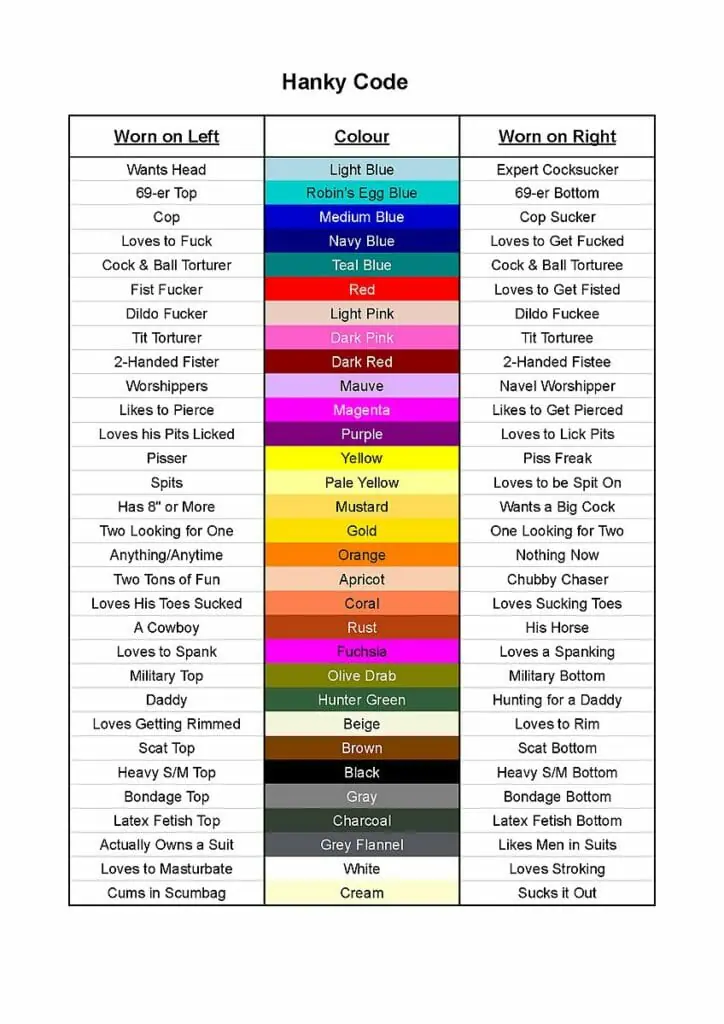

While the gay hanky code has been a longstanding tradition in the LGBTQ+ community, it is not universally recognized or used. Different communities and individuals may have their own interpretations of the meanings of different colors and placements.
Some people also find hanky codes to be outdated or constricting and prefer to communicate their interests and desires directly with their partners. After all, we do live in a modern era with gay hook-up apps with emojis and all your fetishes listed…
Others think it is a genius idea, as it communicates so much with no words and helps you quickly pick people with similar tastes as you out from a crowd of people. Whatever you think of them, it is important to keep the history behind hanky codes in mind and recognize that they are inseparable from gay and LGBTQ history.

